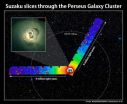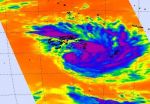(Press-News.org) Menlo Park, Calif. — Scientists have found the strongest evidence yet that a puzzling gap in the electronic structures of some high-temperature superconductors could indicate a new phase of matter. Understanding this "pseudogap" has been a 20-year quest for researchers who are trying to control and improve these breakthrough materials, with the ultimate goal of finding superconductors that operate at room temperature.
"Our findings point to management and control of this other phase as the correct path toward optimizing these novel superconductors for energy applications, as well as searching for new superconductors," said Zhi-Xun Shen of the Stanford Institute for Materials and Energy Science (SIMES), a joint institute of the Department of Energy's SLAC National Accelerator Laboratory and Stanford University. Shen led the team of researchers that made the discovery; their findings appear in the March 25 issue of Science.
Superconductors are materials that conduct electricity with 100 percent efficiency, losing nothing to resistance. Currently used in medical imaging, highly efficient electrical generators and maglev trains, they have the potential to become a truly transformative technology; energy applications would be just one beneficiary. This promise is hampered by one thing, though: they work only at extremely low temperatures. Although research over the past 25 years has developed "high-temperature superconductors" that work at warmer temperatures, even the warmest of them—the cuprates—must be chilled half-way to absolute zero before they will superconduct.
The prospect of being able to dramatically increase that working temperature, thus making superconductors easier and cheaper to use, has kept interest in the cuprates at the boiling point. But to change something you have to understand it, and a puzzle called the pseudogap has stood in the way.
One hallmark of a superconductor is a so-called "energy gap" that appears when the material transitions into its superconducting phase. The gap in electron energies arises when electrons pair off at a lower energy to do the actual job of superconducting electric current.
When most of these materials warm to the point that they can no longer superconduct, the electron pairs split up, the electrons start to regain their previous energies, and the gap closes. But in the cuprates, the gap persists even above superconducting temperatures. This is the pseudogap, and it doesn't fully disappear until a second critical temperature called T* (pronounced "T-star") is reached. T* can be 100 degrees higher than the temperature at which superconductivity begins.
The electrons in the pseudogap state aren't superconducting—so what are they doing? That's the puzzle that's had condensed matter physicists scratching their heads for two decades.
"A clear answer as to whether such a gap is just an extension of superconductivity or a harbinger of another phase is a critical step in developing better superconductors," Shen said.
In work done at SLAC's Stanford Synchrotron Radiation Lightsource, Lawrence Berkeley National Laboratory's Advanced Light Source and Stanford University, Shen's team looked at a sample of a cuprate superconductor from the inside out. They examined electronic behavior at the sample's surface, thermodynamic behavior in the sample's interior, and changes to the sample's dynamic properties over time using a trifecta of measurement techniques never before employed together.
"There is much to be said about using the same material and three different techniques to tackle the problem," commented condensed matter physicist Sudip Chakravarty of the University of California Los Angeles, who was not involved in the research. "Even after decades of research this is a key unanswered question."
The team's findings: electrons in the pseudogap phase are not pairing up. They reorganize into a distinct yet elusive order of their own. In fact, the new order is also present when the material is superconducting; it had been overlooked before, masked by the behavior of superconducting electron pairs.
Simply knowing the pseudogap indicates a new phase of matter provides a clear signpost for follow-up research, according to Ruihua He, a post-doctoral researcher at the Advanced Light Source and first author of the paper. He outlined the next steps: "First to-do: uncover the nature of the pseudogap order. Second to-do: determine whether the pseudogap order is friend or foe to superconductivity. Third to-do: find a way to promote the pseudogap order if it's a friend and suppress it if it's a foe."
According to Makoto Hashimoto, a coauthor on the paper and SSRL staff scientist, their work "makes the high-temperature superconductor roadmap much clearer than before, and a good roadmap is important for any big science project."
INFORMATION:
This advance was made possible by a strong collaboration between Shen's team and teams of researchers from SIMES (led by Aharon Kapitulnik), LBNL (led by Joseph Orenstein) and the ALS (led by Zahid Hussain), the sample growers from the National Institute of Advanced Industrial Science and Technology (led by Hiroshi Eisaki), as well as SIMES theorists Steve Kivelson and Thomas Devereaux.
The Stanford Institute for Materials and Energy Science, SIMES, is a joint institute of SLAC National Accelerator Laboratory and Stanford University. Research at SIMES is supported in part by the U.S. Department of Energy's Office of Science.
SLAC is a multi-program laboratory exploring frontier questions in photon science, astrophysics, particle physics and accelerator research. Located in Menlo Park, California, SLAC is operated by Stanford University for the U.S. Department of Energy Office of Science.
Lawrence Berkeley National Laboratory, a U.S. Department of Energy national laboratory managed by the University of California for the DOE Office of Science, is a world leader in innovative science, advanced computing, and technology that makes a difference.
High-temperature superconductor spills secret: A new phase of matter
2011-03-25
ELSE PRESS RELEASES FROM THIS DATE:
Access Legal Named Best Provider of Home Purchase and Sale Conveyancing Services
2011-03-25
Access Legal, the law firm from Shoosmiths, has been named best provider of home purchase and sale conveyancing services by the Conveyancing Alliance.
The national law firm came top in a survey conducted by the Conveyancing Alliance which was voted for by estate agents. Users of the Conveyancing Alliance portal ranked law firms on several service standards including communication levels, speed of delivery and client feedback.
Client feedback was a key area for Access Legal, as it is very customer focused and aims to treat people as individuals rather than just another ...
LSUHSC research finds protein that protects cancer cells from chemo and radiation therapy
2011-03-25
New Orleans, LA – Research led by Daitoku Sakamuro, PhD, Assistant Professor of Pathology at LSU Health Sciences Center New Orleans and the LSUHSC Stanley S. Scott Cancer Center, has identified a protein that enables the activation of a DNA-repair enzyme that protects cancer cells from catastrophic damage caused by chemo and radiation therapy. This protein, called c-MYC oncoprotein, can initiate and promote almost all human cancers and discovering the role it plays in cancer treatment resistance may lead to advances that save lives. The work is published in the March 29, ...
UBC researchers develop new model to predict the optical properties of nano-structures
2011-03-25
University of British Columbia chemists have developed a new model to predict the optical properties of non-conducting ultra-fine particles.
The finding could help inform the design of tailored nano-structures, and be of utility in a wide range of fields, including the remote sensing of atmospheric pollutants and the study of cosmic dust formation.
Aerosols and nano-particles play a key role in atmospheric processes as industrial pollutants, in interstellar chemistry and in drug delivery systems, and have become an increasingly important area of research. They are ...
Littlewoods Europe Announces Launch of Wish List Service
2011-03-25
Littlewoods Europe has announced the addition of a wish lists feature to its website.
The wish list service is new to the Littlewoods Europe site and it allows customers to save items they are interested in and then come back later and purchase the items directly from their wish list, with the list keeping a record of the items which have been purchased and the items which are still to be bought.
The wish list service also allows the creation and naming of multiple lists for one account. This means that customers can organise lists in the way that is best suited ...
New research suggests wild birds may play a role in the spread of bird flu
2011-03-25
LAUREL, Md. -- Wild migratory birds may indeed play a role in the spread of bird flu, also known as highly pathogenic avian influenza H5N1.
A study by the U.S. Geological Survey, the United Nations Food and Agriculture Organization and the Chinese Academy of Sciences used satellites, outbreak data and genetics to uncover an unknown link in Tibet among wild birds, poultry and the movement of the often-deadly virus.
Researchers attached GPS satellite transmitters to 29 bar-headed geese – a wild species that migrates across most of Asia and that died in the thousands ...
Integral spots matter a millisecond from doom
2011-03-25
ESA's Integral gamma-ray observatory has spotted extremely hot matter just a millisecond before it plunges into the oblivion of a black hole. But is it really doomed? These unique observations suggest that some of the matter may be making a great escape.
No one would want to be so close to a black hole. Just a few hundred kilometres away from its deadly surface, space is a maelstrom of particles and radiation. Vast storms of particles are falling to their doom at close to the speed of light, raising the temperature to millions of degrees.
Ordinarily, it takes just a ...
New PMP Exam Simulator Launched by OSP International LLC
2011-03-25
OSP International LLC has today launched The PM Exam Simulator (http://www.pm-exam-simulator.com), a tool to help candidates for PMI's Project Management Professional (PMP) exam to prepare effectively.
This new PMP Exam Simulator offers unlimited online access to over 1,800 exceptionally realistic PMP exam practice questions. "Anyone who has sat the PMP exam knows that studying the PMBOK Guide and having 35 contact hours is just not enough," says Cornelius Fichtner, PMP, President, OSP International LLC. "When I talk to successful candidates about their experiences with ...
Suzaku shows clearest picture yet of Perseus Galaxy Cluster
2011-03-25
X-ray observations made by the Suzaku observatory provide the clearest picture to date of the size, mass and chemical content of a nearby cluster of galaxies. The study also provides the first direct evidence that million-degree gas clouds are tightly gathered in the cluster's outskirts.
Suzaku is sponsored by the Japan Aerospace Exploration Agency (JAXA) with contributions from NASA and participation by the international scientific community. The findings will appear in the March 25 issue of the journal Science.
Galaxy clusters are millions of light-years across, and ...
NASA satellite attends the birth of Tropical Storm Bune in Southern Pacific
2011-03-25
It's not unusual for NASA satellites to attend the birth of tropical cyclones, and NASA's Aqua satellite was there when Tropical Cyclone Bune was born early today in the South Pacific Ocean.
Bune developed from System 99P, a low pressure area that was about 200 miles southeast of Suva, Fiji yesterday, March 23. The low intensified into tropical depression 19P and today strengthened further into Tropical Storm Bune.
A Tropical Cyclone Alert is in force for Lau, Lomaiviti and nearby smaller islands. A strong wind warning is also in force for the Lau group, Lomaiviti group ...
WARHEADS Teams Up with USA Ultimate
2011-03-25
WARHEADS, the authentic, edgy sour candy, has signed up to be a leading sponsor of the 2011 USA Ultimate College Championships being held in Boulder, Colorado, May 27th-30th. Ultimate, a fast paced, non-stop action team sport, combines the endurance of soccer with the aerial passing of football using a high-tech plastic disc. As the national governing body of Ultimate, USA Ultimate's membership topped 35,000 in 2010 and includes groups of all ages and genders. Over 700 collegiate teams will test their skills in the upcoming Championship series, which culminates with the ...




